
Ottumwa is a city in and the county seat of Wapello County, Iowa, United States. The population was 25,023 at the 2010 U.S. Census. Located in the state's southeastern section, the city is split into northern and southern halves by the Des Moines River.
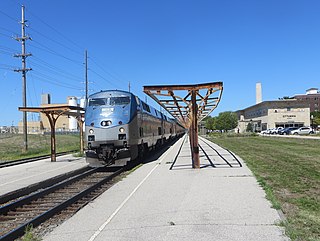
Ottumwa is an Amtrak intercity train station in Ottumwa, Iowa, United States. The station was originally built by the Chicago, Burlington and Quincy Railroad, and has been listed as Burlington Depot by the National Register of Historic Places since November 26, 2008. It became a contributing property in the Historic Railroad District in 2011.

Ottumwa Regional Airport, formerly Ottumwa Industrial Airport, is six miles northwest of Ottumwa, in Wapello County, Iowa. The airport is owned by the City of Ottumwa and is operated by the Airport Advisory Board. It is listed as a general aviation airport in the National Plan of Integrated Airport System (NPIAS) and as an Enhanced Service Airport in the Iowa Aviation System Plan.
Second Street Historic District may refer to:

Ottumwa Public Library is a public library located in downtown Ottumwa, Iowa, United States. The current building was built in 1901. It is part of the Central Park area, which is the civic center of the community. It includes the Wapello County Courthouse, Ottumwa City Hall, and St. Mary of the Visitation Catholic Church. The library was listed on the National Register of Historic Places in 1984.
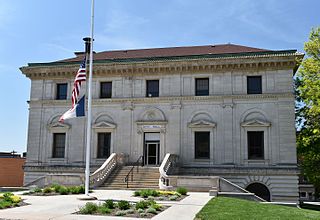
Ottumwa City Hall is the official seat of government for the city of Ottumwa, Iowa, United States. The building originally served as a post office and federal courthouse. It is part of the Central Park area, which includes: Ottumwa Public Library, Wapello County Courthouse and St. Mary of the Visitation Catholic Church. The building was listed on the National Register of Historic Places in 1976.
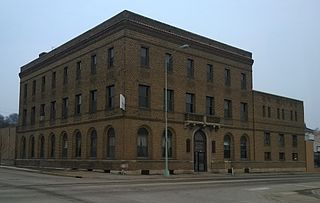
Ottumwa Young Women's Christian Association , also known as Your Family Center, is a historic building located in Ottumwa, Iowa, United States. Its significance is related to the local social movement that provided a safe place to live for young women and education programs that encouraged their business and professional development. The Young Women's Christian Association (YWCA) was established in Ottumwa in 1894 by 64 charter members. They began with opening reading and rest rooms before they opened a boarding house. In 1903 they acquired the former First Baptist Church building for their use. They cooperated with the local Young Men's Christian Association (YMCA) for recreational and camping activities. The YMCA built a new larger facility in 1921 and the YWCA considered buying their old building, but they decided to build their own building instead.

The Benson Building, also known as the Union Bus Depot, was an historic building located in downtown Ottumwa, Iowa, United States. The Tudor Revival style commercial building was completed in 1930. The one-story structure was composed of highly textured, painted brick. The façade featured a steeply-pitched gable roof and half-timbering. The building was originally used as an indoor miniature golf course. Its significance was attributed to its architecture. It was individually listed on the National Register of Historic Places in 1995 as a part of the Ottumwa MPS. In 2016 it was included as a contributing property in the Greater Second Street Historic District.
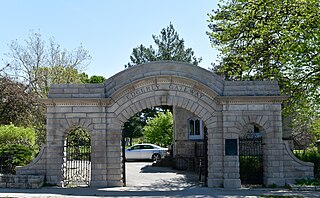
Ottumwa Cemetery is a public cemetery located in Ottumwa, Iowa, United States. The entrance area of the cemetery forms a historic district that was listed on the National Register of Historic Places in 1995. At the time of its nomination it was composed of four resources, which included two contributing buildings and two contributing structures.

Edward Hammatt was an architect in the United States. He designed several notable buildings that are listed on the National Register of Historic Places.

Trinity Episcopal Church is located in Ottumwa, Iowa, United States. It is a parish church of the Episcopal Diocese of Iowa. The building is a contributing property in the Fifth Street Bluff Historic District on the National Register of Historic Places.

The Fifth Street Bluff Historic District is a nationally recognized historic district located in Ottumwa, Iowa, United States. It was listed on the National Register of Historic Places in 1998. At the time of its nomination it contained 67 resources, which included 40 contributing buildings, three contributing structures, and 24 non-contributing buildings.

The Vogel Place Historic District is a nationally recognized historic district located in Ottumwa, Iowa, United States. It was listed on the National Register of Historic Places in 1995. At the time of its nomination it contained 158 resources, which included 101 contributing buildings, six contributing structures, and 51 non-contributing buildings.
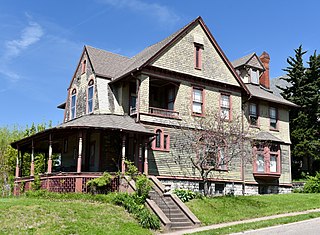
Court Hill Historic District is a historic district located in Ottumwa, Iowa, United States. It is a residential area of large homes with a few small homes in between. The district was listed on the National Register of Historic Places in 1998 as a part of Ottumwa MPS. At the time of its nomination it contained 84 resources, which included 56 contributing buildings, two contributing structures, 25 non-contributing buildings, and one non-contributing site.
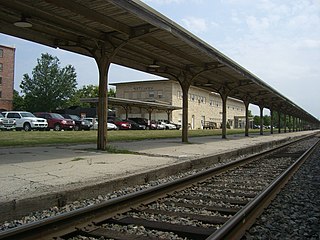
The Historic Railroad District is located in Ottumwa, Iowa, United States. The historic district includes four separate properties: the Burlington Veterans Clubhouse (1935), the Burlington Depot (1951), the Burlington Northern/Sante Fe passenger canopies (1951) and Ballingall Park (1951). It was listed on the National Register of Historic Places in 2011.
George M. Kerns was an architect in Iowa.
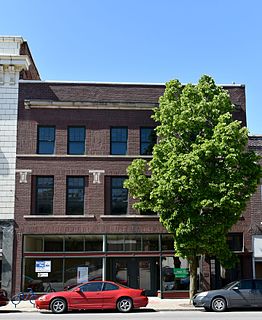
The J.W. Garner Building is a historic building located in Ottumwa, Iowa, United States. Built in 1911, it is the work of local architect George M. Kerns. The three-story red brick structure with limestone details exhibits a subdued Neoclassical style. The windows on the second floor are grouped into bays divided by brick pilasters with two windows per bay. The third floor windows have no such division and have a limestone belt course for their sills. There is a simple cornice near the top of the facade. The building was individually listed on the National Register of Historic Places in 2010. In 2016 it was included as a contributing property in the Greater Second Street Historic District.

The St. Joseph Hospital Historic District is a former Catholic hospital campus and nationally recognized historic district located in Ottumwa, Iowa, United States. It was listed on the National Register of Historic Places in 2015. At the time of its nomination it contained three resources, which included two contributing buildings, and one contributing structure. Previously, the hospital building was included as a contributing property in the Vogel Place Historic District.
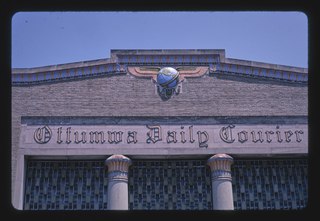
The Greater Second Street Historic District is a nationally recognized historic district located in Ottumwa, Iowa, United States. It was listed on the National Register of Historic Places in 2016. At the time of its nomination it contained 12 resources, which included 10 contributing buildings, one non-contributing building, and one non-contributing site. It is located on the northeast side of the central business district. The commercial buildings located here are mostly architect designed, which gives each of them a unique appearance. At the same time, it is a cohesive collection of buildings that exhibit early 20th century styles that are not found anywhere else in Ottumwa. They were either built or they had a new facade added from 1903 to 1930. Eight of the buildings are free-standing, and two of them are set back on their lots. For the most part the buildings housed professional offices and leisure activities. A few of them housed retail business. The Benson Block, the Benson Building, and the J.W. Garner Building are all individually listed on the National Register of Historic Places. Another building is the headquarters of the local newspaper, the Ottumwa Courier.
Croft & Boerner was an architectural and engineering firm based in Minneapolis, Minnesota, United States. It was a partnership of Francis Boerner (1889–1936) and Ernest Croft (1889–1959). Several of their works are listed on the U.S. National Register of Historic Places for their architecture.


















